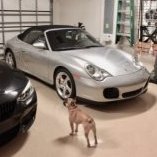Welcome to RennTech.org Community, Guest
There are many great features available to you once you register at RennTech.org
You are free to view posts here, but you must log in to reply to existing posts, or to start your own new topic. Like most online communities, there are costs involved to maintain a site like this - so we encourage our members to donate. All donations go to the costs operating and maintaining this site. We prefer that guests take part in our community and we offer a lot in return to those willing to join our corner of the Porsche world. This site is 99 percent member supported (less than 1 percent comes from advertising) - so please consider an annual donation to keep this site running.
Here are some of the features available - once you register at RennTech.org
- View Classified Ads
- DIY Tutorials
- Porsche TSB Listings (limited)
- VIN Decoder
- Special Offers
-
OBD II P-Codes - Paint Codes
- Registry
- Videos System
- View Reviews
- and get rid of this welcome message
It takes just a few minutes to register, and it's FREE
Contributing Members also get these additional benefits:
(you become a Contributing Member by donating money to the operation of this site)
- No ads - advertisements are removed
- Access the Contributors Only Forum
- Contributing Members Only Downloads
- Send attachments with PMs
- All image/file storage limits are substantially increased for all Contributing Members
- Option Codes Lookup
- VIN Option Lookups (limited)
-
Posts
67 -
Joined
-
Last visited
About dphil66
- Birthday 05/01/1971
Contact Methods
-
Website URL
http://
Profile Information
-
Gender
Male
-
Interests
Cross-country trips in the spaceship, the look on people's faces when I tell them we drive our Porsches in the winter, and getting tickets for things I didn't even do.
Profile Fields
-
From
Grand Rapids, Michigan, USA
-
Porsche Club
PCA (Porsche Club of America)
-
Present cars
2004 Porsche Cayenne Turbo, Lapis Blue Metallic/Sand Beige (named Blue Thunder)
1999 Porsche 911 Carrera 4, Midnight Blue Metallic/Space Grey (named Sapphire)
1998 Porsche Boxster, Arena Red/Graphite Grey (named Ruby) -
Future cars
More Porsches!
-
Former cars
1980 Porsche 924 Turbo S, 1985.5 Porsche 944 , 1986 Porsche 944 Turbo, 1997 Porsche Boxster, 1985 (early) Porsche 944
Recent Profile Visitors
dphil66's Achievements

Member (1/1)
6
Reputation
-
Also have a 2008 Cayenne Turbo...and wanted to put the same Hawk LTS (green package) pads on it that I put on my '04 Cayenne Turbo, and they say they have two part numbers that are compatible with the 2008, but they are NOT compatible. The 2008 Turbo has the 368mm discs / 6-piston calipers, and those Hawk pads will NOT fit. The larger calipers have to be removed to change pads, whereas with the older 350mm versions on older Turbos, you just remove the retaining pin and spring and the pads come straight out without removing the caliper. Picture of the 368mm version: It also seems the 2009-2010 models had the larger 380mm front brakes from the prior year's Porsche Cayenne Turbo Power Kit, so the 2008s had different front pads than the 2009-2010. The only pads for the 2008 seem to be...from some good information I found at "some other place" on the interwebs. A very nice fellow posted this info as brake pad part numbers for the '08 Turbo: Front Pads: Porsche Part # 955.351.939.63 Pagid Part # T1798 EBC Yellowstuff Part # DP41835R Carbotech Part# CT1349 Rear Pads: Porsche Part # 955.352.939.63 Pagid Part # T1863 EBC Yellowstuff Part # DP41836R Carbotech Part# CT1350
-
I put Hawk LTS pads all around on my 2004 Cayenne Turbo, and the virtual elimination of brake dust is fantastic! Also, you guys are right that they don't have the same "feel" as factory, however I always thought the factory brakes were WAY too grabby...I never liked them. Same with my 2008 Cayenne Turbo. Driving these with factory pads back to back with our Boxster with factory pads, and the CTT's brakes are just way to sensitive. You get a hard initial bite, but then have to do a real leg press to get any real stopping power The Hawk LTS pads totally fix the grabby brake feel, and they give better ultimate stopping power when you're really standing on them vs. the factory pads. I like that they feel much more progressive and linear, and are much closer in feel to the sports car. Those factory pads are designed for soccer moms who want a light touch on the brakes as they slow down for the stop sign in front of little Johnny's school a quarter mile before they get to it. It's a reassuring bite for people who never actually brake (or drive) hard. The Hawk pads are proper pads, with more force required to initialize, yes, but ultimately far more linear when you get deeper into trouble. I like them WAY better. Plus, virtually zero dust. I do a deep clean maybe twice a summer on my daily driver's wheels.
-
Hi guys, Just thought I'd add my experience here in case it helps somebody... I was having this problem with our '98 Boxster 2.5: (video not my car, but same problem) http://www.youtube.com/watch?v=1lVGBfjHgAk Our local Porsche dealer narrowed the issue down to a sticking Idle Control Valve (ICV). They removed it, de-gunked it really well, and had it moving freely before re-installing it just to try that out. The problem went away. They asked if I wanted to wait for them to get a new part and replace it while they had it opened up, but since I just literally that day handed them almost $1,500 for a new carden shaft on the Cayenne Turbo, I said, "Let's just see how it goes after being cleaned up." A new ICV is about $500 at the dealer, and about 1.5 hours of labor. This problem had been intermittent - it would occur maybe once a year, and then over the course of an hour or so, the idle revving would be less severe. It might start going from idle up to 2,700, and when it started to abate, it might just go from idle to 2,200....then to maybe 1,800...then it would go back to normal static idle. This has been a real bugger to diagnose because of its intermittent nature. But there you have it. It could not find a stable idle, and the computer kept trying to compensate with the revving...all because the Idle Control Valve was sticking. We drive the car daily, a lot, even in the winter (with snow tires and a hard top). So it is truly a daily whip. We bought the car with only 10k miles on it in 2006. It now has about 204,000 miles, and still has the original clutch. Our air-oil separator has just been replaced as well. OT, but we've never had an RMS leak, most likely because it's driven daily, all year long. And even though she sees plenty of red-line revs, never an issue with the Intermediate Shaft Bearing. Mobil 1 and factory filters every 15k just like the book says. And again, still the original clutch. Except for these two recent issues (ICV and air-oil sep), she's been a real champ.
-
I just replaced the front brake pads on my 2004 Cayenne Turbo, and was looking for something with good feel, low noise, and more than anything - less brake dust than the OEM pads. I ended up using Hawk LTS pads (light truck series, in the green package), Hawk p/n HB501Y.625. I found some pros and cons, but mostly pros. PRO: The Hawk LTS pads throw WAY, way, way way way less brake dust than the OEM pads. My wheels were cleaned & detailed 3 weeks ago, and at the moment, the rear wheels (with OEM pads) have about 50% more dust on them than the front wheels. This is absolutely awesome. With the OEM front pads, I used to get brake dust on the SIDE of the vehicle, like, on the door panels, on the door handles even. No more. When it comes to dust, these are quite awesome. PRO: The brake feel is less 'grabby' than the OEM pads. This is a good thing, as I thought the brakes were too abrupt with the OEM pads, an example where I thought the factory got the calibration wrong in this vehicle. PRO: Cost was a lot cheaper than OEM, and pads are pricey on the Cayenne. (Surprisingly, the Cayenne rotors are cheaper than those for my 911, but the pads were a lot more...wtf?) NEUTRAL: I can't speak to the high-speed, high-performance aspect of the pads because I drive this as a street car. Spirited driving in this big fat pig, to be sure, but I'm not sure how they'd compare to the OEM pads on the track. Because I don't plan on tracking my CTT, I guess I don't care. CON: The molded plastic part of the sensor wires broke when I pushed them home into the notches in the pads. The portion that broke was the flange that basically holds the sensor in the pad left-to-right (relative to the vehicle), but once installed they stayed in place more or less. You may have to file or work the receiving pad to prevent this, and it was disappointing. I have no noise from these pads, however I did replace the retainer pins, bolts, and springs that come with the factory hardware package that is recommended for every brake change. I also used the normal red grease between the pads' backsides and the caliper pistons. No noise is good noise... Hope this helps, Dan
-

rear brake pads
dphil66 replied to demarconstruction's topic in 9PA, 9PA1 (Cayenne) Part Number Requests
Loren, I bet you're correct on that reasoning. Wheel fitment over big brakes it critical, and those numbers indicating minimum wheel size would make it easier to discern. And still, 380mm is a huge brake rotor...the same diameter of the wheels on my VW Eurovan! -

rear brake pads
dphil66 replied to demarconstruction's topic in 9PA, 9PA1 (Cayenne) Part Number Requests
Sorry, I just can't take it anymore...I keep reading about 17" brake rotors on Cayenne forums, and feel the need to point out that there are in fact 25.4 mm in every 1.0 inch. Therefore: 380mm = 14.960" 350mm = 13.780" 300mm = 11.811" As much as I'd love to have 17" brake rotors on my Cayenne, it just ain't so... BTW, I believe the silver and red calipers between the S and Turbo are the same, just different paint color. Black calipers on the Cayenne V6 are smaller. I also believe the 380mm brakes are only found on the Turbo S models, and on Turbos with the (very expensive) Powerkit option, which basically turn a regular Turbo into a Turbo S by changing intake mainfold, ECU, brakes, and etc. -
This may help those of you looking for a part number, and this feature has been available on Porsche's website for a long time, but you can download the real factory parts catalog for your Porsche right off the Porsche website. This is the same catalog your dealer looks at on their computers when they look up parts for you. Just go to this page on the Porsche site, and select your model: http://www.porsche.com/usa/accessoriesandservices/porscheservice/originalparts/originalpartscatalogue/ You can navigate to this from the top level main page by clicking Personalization and Service >>> Porsche Service >>> Parts and Diagnostic Information >>> Porsche Original Parts Catalog. The factory Porsche website contains many other very useful features and sources of information. Take some time to browse through the lesser-travelled areas, and you may be surprised at the wealth of information you might find. Dan Phillips President, Western Michigan Region, Porsche Club of America
-
Another person posting on this forum recommended a 21 mm spacer for 10x18 et65 rears on a Boxster, instead of an 18mm spacer. He said otherwise, the tire rubs on the strut, I presume at maximum suspension travel. It is common that 18mm spacers are offered to make the 10x18 et65 rims fit on a Boxster from wheel shops, and it does mathematically add up. The Boxster's factory 10x18" wheels are an et47 offset, and 47 + 18 = 65. I am thinking of doing the same on a '98 Boxster (with some factory 18" rims with the et65 offset), and I'll probably play it safe and get a 21 mm spacer set.
-
I have the factory Sport Design wheels on my car (18" two-piece with 10 spokes and bolts all the way 'round), and they are chromed. Since I'm not too fond of chrome, I had a company that advertises in Panorama quote a strip / paint job. Company was Wheel Restoration or something like that in California. They quoted about $600 per wheel, not including shipping and removal / reinstall of tires. They would strip the chrome, polish / grind everything to remove any curb rash, separate the center spokes from the rim, polish the rim and clear-coat (almost a chrome-finish) and paint the center part midnight blue metallic to match the car. Would look sharp, but still, $2400 plus plus.
-
I think this whole engine reliability question is way overblown. There were a small (small!) number of early engines that had problems due to a casting issue at one of the two block casting suppliers, or so I've heard. So the occurrence of factory-related engine problems is trivial. Maybe I should knock on wood here, but my daily-driver 99 C4 has been fine except for a rare cam tensioner issue on bank 1. I also had an oil leak on bank 1. It's been nothing but gas, oil, and spark plugs ever since, with 63k on the clock. My car does not have an RMS problem, and this is with the original RMS from 99. The likely reason? It's driven every day...
-
A bit of a public service message here, but would you like a copy of the factory repair manual? The factory parts lists / diagrams? All of the factory information is available directly from the source. Visit Porsche's web site, and go to the Service area. You can download the parts list / diagrams here. They have every catalog for every model, free to download: Factory Parts Lists Here, you can purchase downloads for very reasonable prices, including the factory service manual for your car. A one-year subscription (with unlimited access) costs $5,000, but you can purchase individual documents (the repair manual is an individual document, for example) for only $1.80, and you can even use your credit card. Wiring diagrams for $11. It's electronic and thus saves paper, it's cheaper than a Haynes manual, and it's the real deal. It's pretty nice: https://techinfo2.porsche.com/PAGInfosystem...r?Type=GVOStart
-

Determining 996 clutch life
dphil66 replied to ralegen's topic in 996 Series (Carrera, Carrera 4, Carrera 4S, Targa)
My dealer in Michigan quoted about $1300 P&L... They charge $105/hr for labor. They also give you a 10% parts discount if you're a PCA member. By the way, my old 944 had a hydraulic clutch...I just assumed they all did. My current car - a '99 C4 - does it actually have a cable-operated clutch, or is the mechanic talking about the '02 have it all wrong? I haven't seen a cable-operated clutch in many modern cars... -
My wife uses the Kensington Pico for her iPod Nano in her Boxster. It's an FM transmitter that matches the Nano very well. In our view, an FM transmitter is a better solution because: 1) Nothing to install in your vehicle, just tune the factory radio to a particular station to pick up the transmitter's signal 2) Works in all of your vehicles, in your shop, in your house, on your boat, and anywhere you have an FM radio, with only a single $50 item to purchase 3) Freedom to place your iPod, while playing, in a concealed place like your armrest or glovebox. I know there are mixed reviews on FM transmitters, but we live in an area fairly saturated with FM stations, and we have virtually NO issues with static or interference. It even worked perfectly the last time we were in downtown Chicago. Plus, you won't miss any sound quality because a) the MP3s are massively compressed, and therefore aren't much better than a good FM signal anyway, and B) you're in a noisy car to begin with. The Kensington Pico, and many other FM transmitters, are available on store.apple.com. They even sell versions that are an FM transmitter and an iPod charger (plugs into cigarette lighter) rolled into one. That's my $0.02!
-
Improved winter performance is more a function of the *width* of the wheel/tire, not the *diameter* of the wheel. This is because a tire that is narrow results in a contact patch with the ground that has a smaller surface area. If we make these assumptions: 1) Weight of vehicle is constant (4400 lbs) 2) Front-to-back 'length' of contact patch is constant (8 inches) 3) All 4 wheels are the same contact patch, and receive the car's load equally) Thus, a 7-inch wide tire will result in 4 contact patches that are each 56 square inches, and each bear 1100 lbs of load. The resulting pressure of that contact patch is 19.64 psi. If you had an 8-inch wide tire, the surface area increases to 64 square inches, with a resulting pressure of 17.19 psi. Therefore, changing from an 8-inch wide tire down to a 7-inch wide tire will increase the pressure on your contact patches by 14.3%. This is equivalent to adding 629 lbs of weight to the vehicle. That's a *lot* of kitty litter! Since the force of friction per square inch (how much grip the tires will have) equals the contact patch pressure times the coefficient of friction, skinny tires will have much better grip on wet, icy roads. It's amazing how much difference an inch of width can make. But your logic is right on. As a general rule, 17-inch rims are narrower than larger diameter rims for the same vehicle. And of course, 17-inch rims and snow tires are also cheaper than 18s or 19s. Plus, they tend to get more beat up in the winter, so why not beat up on the cheap ones.






